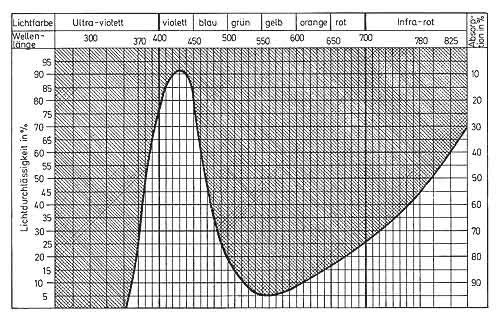Each filter has its own characteristic influence to the light, defined by its transmission curve. A sample chart shows fig. 2. At the top are the colors, below them their respective wave-lengths. On the left hand side is the level of light transmission, that is, the proportion of light not withheld ( absorbed ) by the filter. On the right hand side is the level of absorption, likewise expressed in percentages to which loss through reflection must be added. Both sides therefor add up to one hundred.
The proportion of light above the curve is withheld (crosshatched areas), the lower part transmitted. The area divided into 10 namometer sections through a range from 380 through 780 nm corresponds to the light-sensitive area of the eye. The thick vertical lines at 400 and 700 nm mark the normal photographic range.
Let us follow the curve: transmission of the filter begins somewhat above 350 nm. At 370 nm - at the point the eye begins to see - 25% radiation is already allowed to pass; correspondingly ( see the right hand scale ), 75% is withheld ( absorbed ). At 400 nm, deep violet, transmission has already reached 77%, only 23% is still being absorbed. This filter raches maximum transmission at 430 nm ( 92% ). From here on the curve rapidly falls. At 500 nm ( cyan ), transmission has again sunk to 20%, at 550 nm, to 5%. Then, transmission continuously climbs, at 700 nm 25%, at 780 nm 45%. Thus, the curve is nothing more than the plotting of innumerable test results on a graph. Rough information can be gathered by comparing the colors at the top with the curve.
In case of the specimen curve for our sample filter, the high transmission gives direct information as to the color of the filter. The light transmitted must appear violet because violet has a high level of transmission. Thus, to understand the diagram, no special highly technical knowledge is required.
Light sources emit different portions of spectral light. Daylight has e.g. a much larger portion of blue light in its radiation than a bulb. The consequence from it, different filter factors for the film exposure must be. In addition, the sensor sensitivity has influence on the extension factor. Each film, each sensor "sees and feels" light according to its sensitization with other result.



